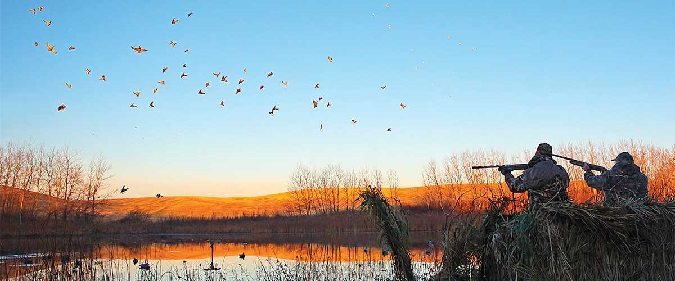
They say that good things come in small packages, but I was a bit surprised when our guide led us to a postage stamp–sized impoundment surrounded by agricultural fields and pastures during early teal season. We were hunting along the Texas Gulf Coast last September, just a few weeks after Hurricane Harvey had brought record rainfall to the region, and the floodwaters still hadn’t completely receded. With so much water all around us, I couldn’t help but wonder how attractive this meager pond would be to the flocks of blue-winged teal pouring into the area.
Any doubts that I had about our spot quickly vanished when, not long after legal shooting light, the unmistakable sound of whistling wings announced the arrival of the first flock of the day. We dropped a few birds from that bunch, but that was just a primer. Soon flock after flock of teal came diving and twisting into our little oasis. Just as fast as we would fire at one group, another would zip in over our small decoy spread, leaving us barely enough time to reload our shotguns. We got our limits quickly, and as we packed our gear and started for the truck, I looked back at that pond in disbelief. It seemed extraordinary that such a small piece of water could be so alluring to ducks.
I shared that story with two Ducks Unlimited staffers who are avid small-water hunting enthusiasts, and neither was surprised by our success. Dr. Scott Stephens and Chad Manlove are both veteran waterfowlers who understand that in some cases the smallest, most overlooked waters produce the biggest hunting rewards. Here’s their advice on how to scout and hunt these hidden honey holes in vastly different parts of the country, early and late in the season.
SETTING UP ON DAY ROOSTS DURING THE EARLY SEASON
Stephens, who is director of regional operations in DU Canada’s Prairie Region, hunts both dabbling and diving ducks on the prairie potholes of Canada and the Dakotas. In early fall, when he’s specifically targeting dabblers, he avoids the larger wetlands that the birds roost on at night. Instead, he seeks out day roosts or “sipping ponds,” as he calls them, pursuing ducks that drop in to quench their thirst and rest as they fly to and from nearby grainfields.
“My experience is that field-feeding ducks tend to stop at these sipping ponds to drink and loaf,” Stephens says. “It’s not entirely clear to me why ducks prefer this small water over night roosts, but it may be that after feeding on dry wheat, barley, or oats, the birds are thirsty and looking for a little water to aid in the digestion process for a big crop full of grain. Some of these wetlands may also offer moist-soil plant seeds and submersed aquatic vegetation that provide essential nutrients that the birds can’t get from feeding only on waste grain.”
These sipping ponds are frequently quite small—just an acre or two in size—and they’re often overlooked by hunters focused on bigger water. This can be a boon for freelance hunters willing to seek out these places. “These day roosts are usually pretty easy to find if you know what to look for,” Stephens explains. “When you’re scouting ducks that are feeding in a field, watch for small bunches getting up and disappearing—without circling—into these small depressions. At times, the whole pond can be covered in ducks.”
If you find one of these ponds after the birds have departed, there will be other telltale signs that you’ve discovered a potential hunting hot spot. “The place will be covered in feathers and there will be duck tracks along the bank and in other shallow areas where the birds stand. If you’re setting up before dawn for a morning hunt, the best indication that you’ve located a day roost is that you’ll find no birds roosting on it overnight,” Stephens says.
A good way to locate these areas is by following the birds after a successful morning hunt. “If you reach your bag limit early, get out and follow the ducks when they leave fields in which they are feeding,” Stephens says. “You can also follow the birds in the early afternoon to see where they are roosting during the day before the evening feed. Ducks use these areas throughout the day, but often only use night roosts before and after shooting hours. That’s another big advantage for hunters.”
Stephens says that these small potholes can remain productive well into the season, as new birds arrive from the north. When these diminutive wetlands freeze up, however, the ducks that remain on the prairies will often move to larger waters, which remain open later in the season.

